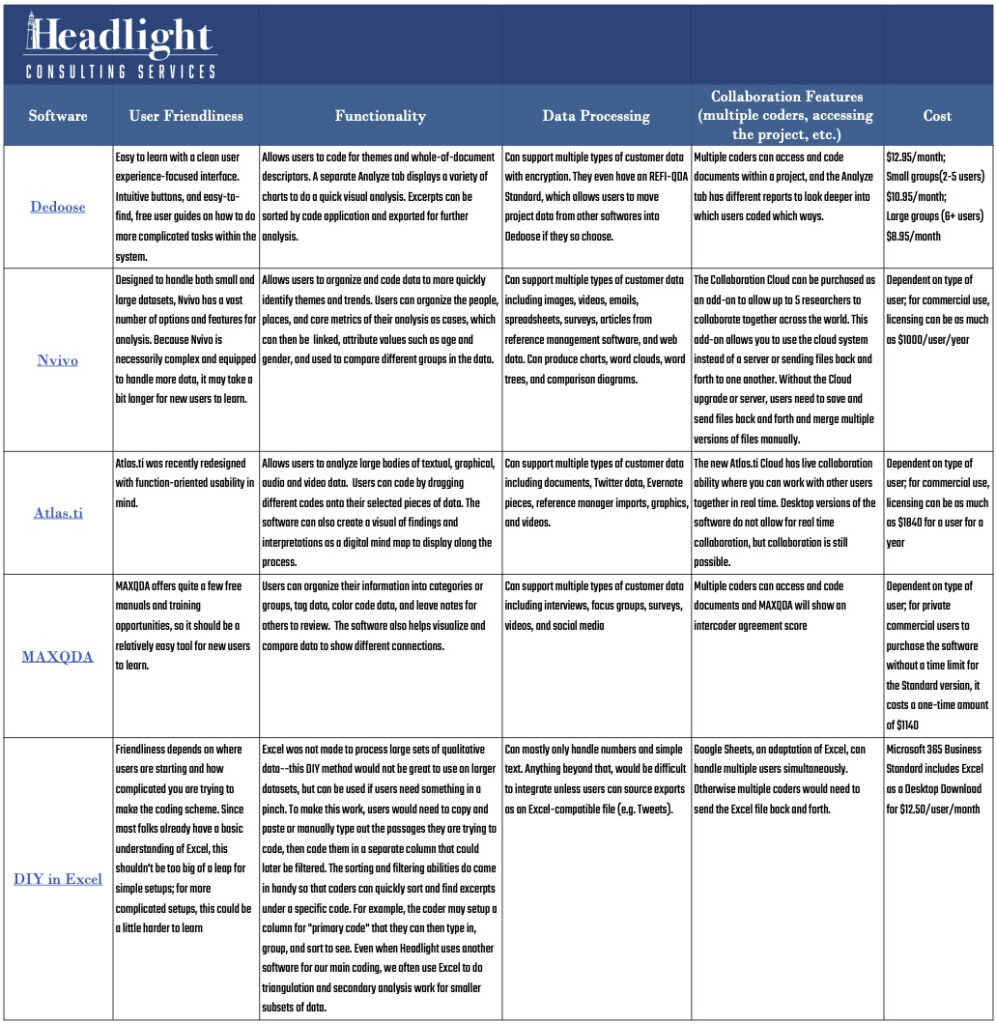By: Chelsie Kuhn, MEL Associate, Headlight Consulting Services, LLP
To facilitate the implementation of recommendations from our last post on Qualitative Rigor, we thought it might be helpful to offer up some considerations for choosing a qualitative analysis software before getting further into the process. Qualitative analysis software allows researchers and evaluators to better organize, clean, code, and analyze qualitative data. By coding our qualitative datasets, we can dig into themes and trends in an unbiased manner, avoiding summaries that only highlight well-articulated interview snapshots or our own biases and assumptions. Without a structured analysis process, findings are often anecdotal and lack the true level of rigor that a good evaluator can bring to the table. This extra layer of rigor allows us to be more confident and effectively “show our work” so that clients can see how we came to the conclusions and recommendations provided and external audiences can have more trust in the findings.
As with any field, not all software is created equally and the different platforms available offer various functionality, price points, and data protection. For someone new to qualitative analysis or an existing qualitative researcher looking to add some structure and additional supports to their processes, this blog and the table below provide a comparative breakdown of some of the top platforms used in qualitative analysis. Please note, however, that the software included below are just a sampling of what is available.
In reviewing the qualitative analysis software listed below, we decided to look at user-friendliness, functionality, data processing, and collaboration features. User-friendliness is an important category for us, especially because coding is usually done by junior MEL staff. That means whatever software is chosen must be easy to learn to ensure quick uptake, consistency of use, and support for proactive problem solving as team members learn the tool on the job. Being a use-focused firm, we also wanted to look at the functionality of different software so that we could choose a multi-tool of sorts–we do not want to have to buy and learn multiple different products if one product can be used many different ways. With this comes the data processing comparison to expand more on what types of media the software can work with; it is likely that over time you will need to work with many different kinds, not just text documents. And because we sometimes work on larger products, we need something with collaboration features to support multiple coders and projects.

Unless clients require us to use a different platform, at Headlight we are generally champions of Dedoose. The price point makes it an easy addition to any project budget, the software is easy to use, the security and encryption protections are strong, and the analysis is simple to execute. Creating a new project is as simple as clicking a button and the software is easy to learn for those newer to qualitative analysis. While there are many free resources and training materials directly on Dedoose’s webpage, we also recommend Sage Publishing’s Qualitative and Mixed Methods Data Analysis Using Dedoose as a practical resource to have on hand too in case coders need more to reference.
Stay tuned for our next blog in the series which will address the Top 5 Dos and Don’ts of Qualitative Analysis with specific ideas for the coding and analysis process. If you have liked our blog so far and want to be alerted when a new post is published, subscribe to our email notifications. For other questions, please reach out to us at <info@headlightconsultingservices.com>.





Comments
no comments found.